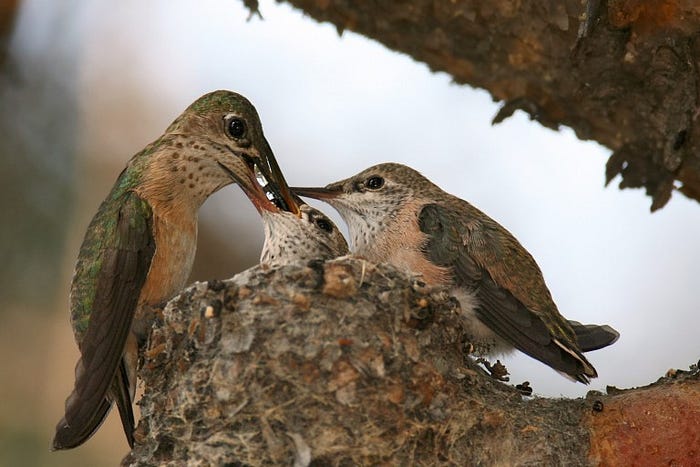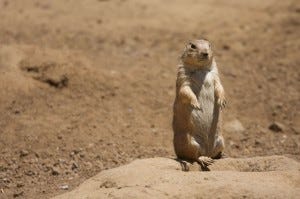The Problem With Altruism
Emily Boring | Nov. 13, 2016

Altruism: a behavior that benefits another (the recipient) at a cost to oneself (the actor).
According to evolutionary theory, altruism shouldn’t exist. Natural selection favors adaptations that increase fitness, an individual’s ability to survive and reproduce. Altruism does the opposite. Selfless actors aren’t rewarded with extra offspring — instead, altruism often comes with a penalty. A prairie dog whistles to warn others of a hawk attack, so the hawk swoops straight down to eat the whistler. Worker ants spend their lives feeding a queen, missing the chance to pass on their individual genes. The best way to reproduce is to be selfish. So why haven’t the genes for altruism died out?

A black-tailed prairie dog whistles to warn the colony of approaching predators. (Photo courtesy of Creative Commons).
For decades, biologists have struggled to explain altruism in evolutionary terms. There’s reciprocal altruism: a vampire bat regurgitates blood to another and receives a “payback” meal later on. There’s sexual selection: male chimps look more attractive to females if they groom others or share food. There’s kin selection. Altruism might not benefit the individual actor, but maybe it increases “inclusive fitness:” passing on genes within a family or lineage. Hamilton’s Rule puts kin selection into numbers: c< r x b. The cost to the actor must be less than the benefit times the “relatedness” between the actor and the recipient. Mothers and children share half their genes, so r is ½. Same for siblings. An uncle-nephew share ¼, cousins share 1/8, and so on. Once, biologist J.B.S. Haldane was asked, “Would you lay down your life for your brother?” “No, but I would for two brothers or eight cousins,” he replied.
For all I know, Hamilton’s hypothesis and the other explanations for altruism are correct. But I think that all of these solutions miss the point. They arise in response to a limited concept of evolutionary biology. Biology asks: how can we explain the diversity of life around us? Evolution answers: all form and behavior can be reduced to the underlying need to survive and reproduce. Like all scientific reductions, this “golden rule” leads to some helpful generalizations. But it also limits our ability to ask interesting questions. The problem with altruism isn’t, “How can we reconcile it within the doctrine of evolution?” Instead, we should ask: Should we reduce everything to survival and reproduction? Can all of life’s diversity be explained? What do we lose or gain by thinking this way?
Let’s look again at Hamilton’s rule: c< r x b. The equation rests on the concept of inclusive fitness. As long as altruism helps your relatives more than it hurts you, there’s evolutionary incentive for selflessness: more of your family’s genes will get passed on. Inclusive fitness allows altruism to fit neatly into the golden rule of evolutionary theory: all behavior supports survival and reproduction.
But something about the simplicity of this explanation makes me pause. The idea that we can reduce something as complex as altruism to mere survival and reproduction implies a causal link between adaptation and fitness. It reinforces one of evolution’s biggest misconceptions: that adaptations arise in response to selective pressure. This isn’t true. The ground squirrel didn’t sit back and think, “Hmmm, I think I’ll evolve the capacity to whistle a warning so my cousins can survive to pass on my genes.” Instead, the genes for squirrel-whistling or chimp-grooming or ant-working arise completely by chance. We can claim that once they spring up, altruistic traits are maintained because they increase inclusive fitness. But the pressure for greater fitness didn’t cause altruism to arise. Nothing about evolution is simple. We need to be sure that the language of our “solutions” doesn’t make it seem that way. When we diminish a trait as intricate as altruism to the basic tenets of survival and reproduction, we risk perpetuating an “if…then” vocabulary that makes evolutionary theory much narrower than it needs to be.
Straightforward explanations of altruism are missed opportunities. In our haste to justify why natural selection would let altruism endure, we ignore a more interesting question: how and why did altruism arise in the first place? We miss out on the chance to think about evolution in a new language: a language of chance, luck, and random mistakes. What we see as “adaptation” is nothing more than lucky error: a random mistake in DNA replication that led to altered proteins and elevated hormones and gradual changes in behavior. The language of “chance” and “mistake” makes some scientists uncomfortable. You don’t come across these words in many biology textbooks. But I think this vocabulary is fascinating. Mutations don’t arise with the goal of increasing survival or reproduction. Life didn’t have to evolve the way it did. Why and how did it come to be this way?
I have another problem with “solutions” that fit altruism into evolution’s tidy criteria. One day long ago, we didn’t know how to explain altruism in terms of fitness. Now, thanks to Hamilton and inclusive fitness, we do. The reduction of altruism to “survival and reproduction” leads us toward a more general faith in functionalism. If we think hard enough, what other complexities can we logically explain? It’s tempting to expand this mindset to areas where it doesn’t belong. There’s a whole field in anthropology that assigns functional explanations to “irrational” behavior. Indian rituals toward cattle are justified as mechanisms for disease management, population control, and maintenance of social structure. An indigenous group’s choice of foraged food is reduced to “optimal diet theory,” a cost-benefit analysis. Is nothing about our world — ritual and religion and culture and choice — beyond the reach of logical explanation?
I feel this conflict firsthand. When I see a field of wildflowers in the Cascade Mountains, my first feeling is wonder — for the pairing of flame-red Indian Paintbrush with the yellow lace of yarrow, or the way the lupin matches the indigo sky. But then the scientist in me steps in. I remember that combinatorial genes express pigment proteins. I remember that variation in color is caused by selective pressure to maximize symbiotic relationships with pollinating insects — nothing more, nothing less. Standing in the middle of the meadow’s palette, I feel torn between two identities. I want to be open to mystery and beauty. I want to observe the scope of life’s diversity, wonder how it happened this way, and say, “Just because.” But I also want to be respected as a scientist.
Here’s the real problem with altruism: not that we can’t explain it, but that we think we can. Hamilton’s rule and others like it reinforce the boundary between areas of un-knowing — religion and poetry and culture and philosophy — and disciplines based on concrete explanation. I think that evolutionary biology has the potential to lie somewhere in the middle. When we let it, evolution offers endless questions. It gives us a language of mistake, luck, and chance. If we pressed “Rewind” on the course of life on our planet, the world that would result would not be same one we see today. What conditions caused life to evolve this way instead of the other infinite possibilities? What does it mean that function so often matches beauty, that life tends toward variation, that things like selflessness evolved at all? To me, these questions are not problems. These are the ones worth asking.

A wildflower field in Oregon’s Cascade Mountains. (Photo courtesy of Creative Commons).
Emily Boring is a junior in Pierson College and co-editor of The Scope. Contact her at emily.boring@yale.edu.
(Featured image: A calliope hummingbird displays parental investment by feeding her chicks. Image courtesy of Creative Commons).

